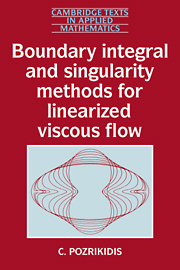5 - Flow due to interfaces
Published online by Cambridge University Press: 13 February 2010
Summary
Introduction
Flows involving interfaces between two different fluids occur in a variety of natural, engineering, and biomechanical applications. Two examples are the flow of a suspension of bubbles, drops, or biological cells, and the flow of a liquid film over a solid surface.
The significance of an interface for the behaviour of a flow is two-fold. From a kinematical standpoint, the interface marks the permanent boundary between two adjacent regions of flow with distinct physical constants. Fluid parcels that are located away from the interface are required to reside in the bulk of the flow at all times. From a dynamical standpoint, the interface is a singular surface of concentrated force. To elucidate this interpretation we note that, in general, the surface forces acting on the two sides of an interface have different values. The difference between these values, termed the discontinuity in the surface force, Δf, depends upon the physical properties of the fluids and the structure and thermodynamic properties of the interface. This dependence may be expressed in terms of a constitutive relationship that may involve a number of physical constants, including the densities of the fluids, surface tension, surface viscosity, surface elasticity, and surface modules of bending and dilatation. An interface is active when Δf is finite, and inactive or passive when Δf = 0. An active interface plays a leading role in determining the dynamics of the flow, whereas a passive interface is simply advected by the ambient flow.
Information
- Type
- Chapter
- Information
- Publisher: Cambridge University PressPrint publication year: 1992
